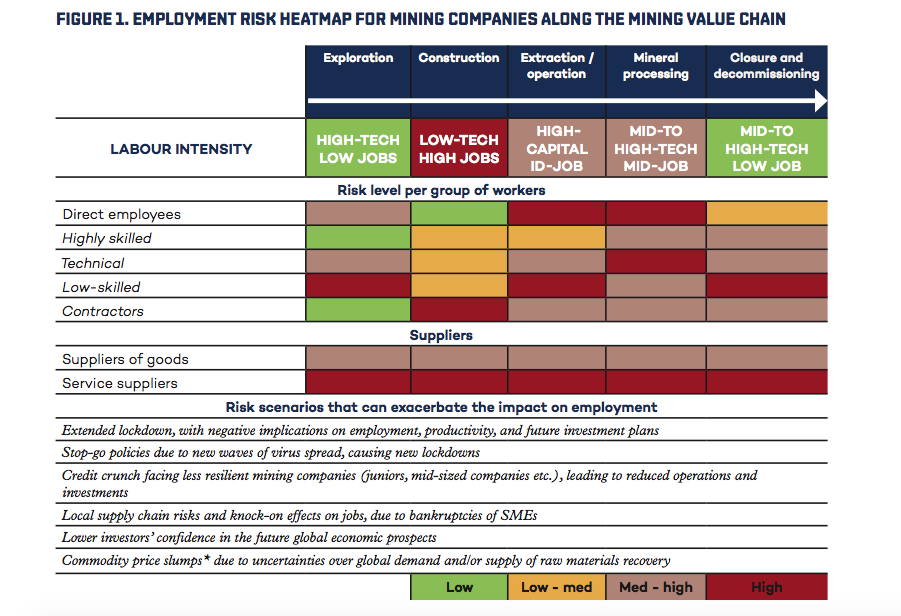The IGF looked at the impact of the pandemic on employment in the mining sector and published a report on the immediate responses taken by governments and mining companies.
Key issues
The paper highlights three key issues: Relief packages must look to the long term; new regulatory frameworks and investments must be developed and the mining sector must create resilient safeguards.
Covid-19 is exposing the weak points of global labour markets, and mining companies of all sizes slowed or halted their operations while workers were forced to stay at home. While new technologies and Internet connectivity allow many employees to work remotely, this option is not available equally to all economic sectors or companies and does not apply to all jobs, IGF points out.
While large-scale mining contributes significantly to many developing countries’ national incomes, it is not a major direct employer due to its capital-intensive nature. According to ICMM2, the mining industry directly contributes around 1%–2% of total employment in a given country.
IGF highlights that large-scale mining plays a critical economic and social role in remote areas and creates more business in host countries.

Labour requirements are not the same across the mining investment cycle, IGF points out. Demand for labour varies according to the number of projects and their levels of development. The construction phase requires a larger number of contractual workers to build mining facilities compared to the operational phase.
Covid-19 is highlighting shortcomings in the labour market
Specific parameters determine the demand for labour, IFG highlights. During the production phase, the types of operations, the degree of mechanization or automation, the types of minerals being extracted, geological specificities, and other criteria will determine the demand for labour.
Local procurement creates employment spillovers through the development of business activities to service the mines. Induced employment opportunities are also created in the local community, through satellite economic activities such as hotels, restaurants and shops. The deeper the linkages, the higher the impact on indirect and induced jobs, the report finds.
Long term effects
The covid-19 pandemic will have longer- term consequences on employment in the large-scale mining sector as a result of impacts on local suppliers and community economic activities, mining capex forecasts and current investments.
According to GlobalData, prior to covid-19, capex expenditure was projected to increase by 11% in 2020. A number of projects delayed and investments put on hold. The top 20 mining companies have announced significant cuts in their capex for 2020: Glencore plans to cut capex expenditure plans from $5.5 billion to $4 to $4.5 billion; Rio Tinto cut at least $1 billion from an initial prevision of $7 billion; and Anglo American revised its capex guidance by about $1 billion.
Structural changes in employment models
Covid-19 is highlighting shortcomings in the labour market. In Australia, the virus is prompting many companies to reduce their FIFO and DIDO workers due to restrictions on travel within the country.
This will leave a permanent mark on the employment model with two possible consequences: increased opportunities for local employees or an accelerated pace of automation of some tasks to reduce future risks, IGF reports.
Drive toward automation
The pandemic may accelerate the pace of technological adoption already in the pipeline, but IGF maintains it is unlikely covid-19 will be determinant in fast-tracking the move toward full automation8 in the near future, in part because of the complexity of the industry, the cost of technology, significant differences in the ability to run robots in various environments, and the likely aversion of investors to big changes in operational models, particularly where there are such uncertainties about the future.
In Chile, the government enacted the Employment Protection Law in April 2020 to protect families’ income from loss of work
Mechanized mines with fewer staff have not slowed their operations to the same extent as labour-intensive mine sites, as experienced in the automated Pilbara mines in Australia, which have recruited more workers as development projects continue, and Syama mine in Mali, whose production remains uninterrupted despite the crisis.
Short term responses
Governments in countries like Canada, Australia, South Africa, The Philippines, Peru, Brazil, and Colombia have declared mineral exploration, processing, and related supply of goods and services as essential services. These measures allow workers that are critical for operations to go back to the mines and allow supply chains to start functioning again.
Some governments are also taking measures to protect employees’ rights, such as obligations for companies to pay insurance, pension, and health contributions during emergency situations. This is the case in Chile, where the government enacted the Employment Protection Law in April 2020 to protect families’ income from loss of work.
In Australia, mining companies are providing extended and paid-leave support to their employees and contractors who required self-isolation or have health vulnerabilities. Similarly, in South Africa, Anglo American is paying the basic salaries of all of its 45,000 employees, guarantee their housing allowances and paying the contributions to medical and pension funds during the lockdown period.
Most relief packages provided by governments are general and cross-sectoral. To make them effective for the mining sector in the long term, IGF asserts measures must be tailored to respond to the realities of the labour situation in the sector.
IGF asserts there needs to be a consistent application of minimum standards with regards to health and safety to protect all workers, across all mining companies, within a given jurisdiction.




